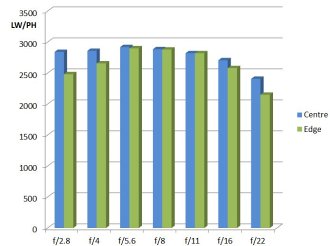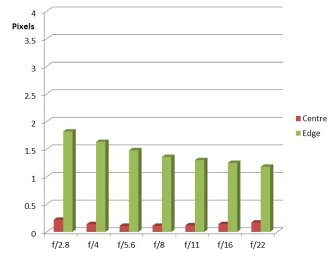Pentax HD PENTAX-D FA 15-30mm F2.8 ED SDM WR Review
Pentax HD PENTAX-D FA 15-30mm F2.8 ED SDM WR Performance
In a similar way to the other new Pentax lenses released, the 15-30mm is definitely of the same design ethos. That is, very good sharpness throughout, regardless of aperture, focal length or centre or edge of the image. The degree of balance is remarkable and is clearly intended to make the most of the entire 35mm-format image area. The pattern of performance closely mimics that of the Pentax 28-105mm and 24-70mm lenses also introduced for the K-1.
How to read our charts
The blue column represents readings from the centre of the picture frame at the various apertures and the green is from the edges.The scale on the left side is an indication of actual image resolution as LW/PH and is described in detail above. The taller the column, the better the lens performance.
For this review, the lens was tested on a Pentax K-1 using Imatest.
Sharpness at 15mm is simply very good centre and edge from f/2.8 through to f/16. It falls away at f/22, as expected, but remains good even here. At 15mm we find -3.44% barrel distortion, which is good for such a wide lens. CA at the centre is almost zero and at the edges well controlled at below 2 pixels width. This is all easily corrected in software.
How to read our charts
Chromatic aberration is the lens' inability to focus on the sensor or film all colours of visible light at the same point. Severe chromatic aberration gives a noticeable fringing or a halo effect around sharp edges within the picture. It can be cured in software.Apochromatic lenses have special lens elements (aspheric, extra-low dispersion etc) to minimise the problem, hence they usually cost more.
For this review, the lens was tested on a Pentax K-1 using Imatest.
20mm shows +0.154% pincushion distortion, a remarkably low figure that is close to perfectly rectilinear. That is, straight lines even at the edge of the field will remain straight. CA follows the same pattern as at 15mm, and the centre figures approach even closer to zero.
20mm sharpness is virtually identical to the wider settings and is incredibly even across the field, being consistently very good. It just drops away at the edges at f/22, but is still good.
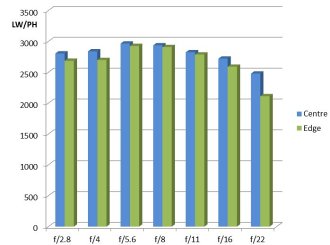 |
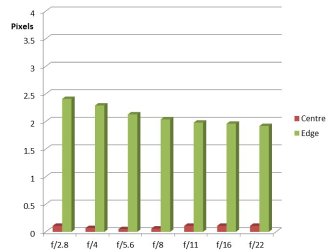 |
| MTF @ 20mm | CA @ 20mm |
24mm gives us a figure of +1.25% pincushion distortion, still an excellent result for an ultra-wide lens, especially a zoom. CA shows the same outstanding central correction, the edges showing fringing but correctable in software.
24mm sharpness shows no sign of dropping. Whereas many zoom lenses would be becoming less and less sharp at longer focal lengths in all the new Pentax zooms this does not seem to be the case. Performance is maintained, as is the remarkable even quality across the frame. The lens at 24mm is very good at the centre and at all apertures. At the edges, the f/2.8 figure falls slightly but results are still good. The edges are very good from f/4 to f/16 and f/22 still yields a good result.
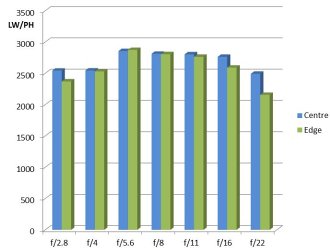 |
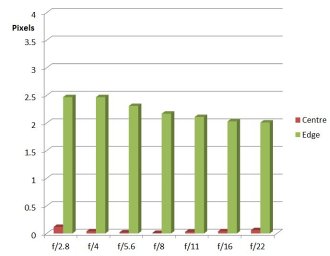 |
| MTF @ 24mm | CA @ 24mm |
At 30mm we have +1.58% pincushion distortion, which is still a good result, although a typical 28mm prime lens would tend to show barrelling, to the handling of straight lines may look different for some shots. It's unlikely to be a problem though, more of academic interest. CA centrally is virtually banished and control at the edges actually improves. All these things can be corrected in software.
30mm sharpness still achieves the same high standard that we see at the other focal lengths and still shows the same edge to edge evenness. Centre and edge are very good from f/2.8 to f/16 and f/22 shows a drop through diffraction effects, although remaining good.
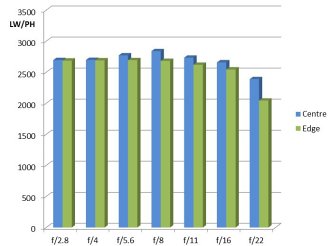 |
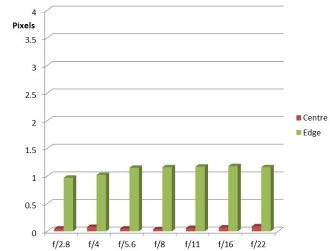 |
| MTF @ 30mm | CA @ 30mm |
Bokeh, the quality of the out of focus areas, is something that we give much more priority to than in the past. The 15-30mm shows lovely smooth transition in those areas and a very pleasant bokeh effect. There are qualities that cannot necessarily be measured in a lens, but the net effect is a very visually appealing image and this lens certainly has that, just as much as the other full frame Pentax zooms.
Flare resistance is also vital, especially in a wide angle with its relatively exposed front element. It seems that the new Pentax HD (High Definition) coating works very well indeed, and flare was not found in any of the images shot into the light.
Value For Money
This lens fills a unique slot in the Pentax repertoire and is an important asset in that range. It is priced at £1499, although as always no doubt this will fall over time.
Nikon, Sony and Canon users will have to look to the Tamron 15-30mm f/2.8 SP Di VC USD lens, priced at £849. Whilst not directly relevant to a Pentax user it does show that Pentax have lost none of their propensity for releasing lenses in unusual and sometimes unique focal lengths. A look through their range of Limited lenses will reinforce this. The closest other marque lens is the Canon 16-35mm f/4 L IS USM at £682.
Although a hefty price tag at its introductory level, nonetheless the HD Pentax 15-30mm f/2.8 ED SDM WR lens delivers the goods and is an essential part of the range. For more options have a look at the Top 10 Best Pentax Lenses.
Add your message
Please login here or if you've not registered, you can register here. Registering is safe, quick and free.
photodo Stats
428 MTF tests
74 in-depth photodo reviews
100+ users join each day
Help the lens community by reviewing or rating a lens today via our lens search
Latest Lens Reviews
- Chinon 28mm f/2.8 Vintage Lens Review
- Canon EF 70-200mm f/4L IS II USM Lens Review
- Samyang AF 85mm f/1.4 EF Review
- Sigma 70mm f/2.8 DG Macro Art Review
- Samyang AF 24mm f/2.8 FE Review
- Meike 50mm f/1.7 Review
- Tamron 70-210mm f/4 Di VC USD Review
- Lensbaby Burnside 35mm f/2.8 Review
- Asahi Super Takumar 50mm f/1.4 Review
- Asahi Super-Multi-Coated Takumar 135mm f/3.5 Review
